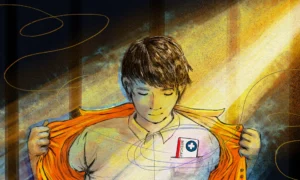
Hang with me, please. This is a story of complex family relations and problems and one that exemplifies the challenges, as well as the benefits, of engaging families in changing juvenile behaviors.
I met Amanda first in a child welfare case when I was a judge in southern Illinois. Because she looked at least 16 years old, I asked the state’s attorney to correct court documents recording her age as only 12. He advised that I should review the entire file, which alleged that she was a runaway and would have been criminally charged with prostitution but for her age. Behind the blue eye shadow, clothes suitable for a hooker and a sullen demeanor, was a girl raped by her father, rejected by her mother and alone in the world except for an unidentified pimp.
As the months rolled on, I learned that she was the daughter of a man well known to the criminal court. In a different child welfare case, he was identified as the father of Amanda’s 14-year-old half-sister who was also the victim of his sexual abuse – let’s call her Jane. Jim, the father, was convicted, and I sentenced him to five years in prison. In the meantime, Amanda entered residential treatment, and at age 14 appeared for a permanency hearing looking like the waifish blonde adolescent that she was – clean and sober, no longer under the influence of her pimp or cocaine. Her custody was returned to her mother, and the case was terminated.
Her older sister Jane’s case had been termed a failure due to her absolute refusal to comply with therapy, counseling or residential placement. But, as the years went by, Jane developed into a good mother to her own children and was a resource for Amanda. Jane occasionally stopped by the courthouse to chat with her public defender, the assistant state’s attorney and me.
Amanda did not fare as well. She backslid from her early progress in juvenile court. She married three different men with substance abuse and criminal backgrounds and had a child by each of them. The three children now are wards of the court in child welfare cases.
Her son was the reason for her stepmother’s phone call to me at Christmastime. The stepgrandmother is married to Gary, once addicted to drugs but now clean. Gary’s son, Ron, was well known in juvenile delinquency court but sobered up in his mid-30s. Ron and Amanda are the parents of the 12-year-old boy in question who is in the custody of his grandfather and step-grandmother by court order and has been ordered to visit with his mother, Amanda, for two hours once a week in a public place.
Amanda and her third husband did have alternate weekend visitation that was reduced due to the medically determined beatings the boy received during that visitation. Because the third husband is now back in prison for unrelated conduct, the court ordered the current visitation that the boy wants to terminate. Everyone in the case is court savvy, and the grandparents do not want to encourage a violation of the order. On the other hand, the boy alleges that Amanda meets him at a restaurant and takes him with unknown men to a house where the adults smoke meth before returning with the child to the court-ordered meeting place.
Although none of the names used here are real, all of these situations actually happened in cases I heard. A court hearing on this case is scheduled for later this month when a judge may learn more about the 12-year-old’s visitation experiences. It’s not likely to be the last time this child and his family will be in courtroom.
Family engagement always has been a necessity in the juvenile justice system’s response to delinquency and child abuse. But my recollection of Amanda’s life story underlined for me just how many tools were not available to us 20 years ago when this story began. We did not have knowledge of adolescent brain development, evidence-based practices or adequate assessment tools. Trauma informed practice might have changed the course of Amanda’s life and created a positive relationship with her own children. Jane’s resilience kept her safe when all the court’s and caseworker’s plans seemed foolish to her. She is now – and always was – a resource for her family. The step-grandmother came forward to protect a non-blood relative. The grandfather and father have turned their lives in a positive direction and are in family therapy with the 12-year-old.
We cannot use a blaming or shaming approach to family chaos. Research supports the positive outcomes for effective family engagement: shorter lengths of stay in out-of-home placement, fewer and less restrictive placements and lower recidivism rates. We must change our vocabulary to move away from terms like “dysfunctional,” “resistant” and “enmeshed,” and we must not ignore basic needs for families to survive – food, clothing, shelter and medical care.
While this family’s relationships might appear dire, there are resources and resiliencies here too. Even in this complicated family situation, there are caring adults who can partner in – and lead – efforts to improve the outcomes of the children involved. The job of a juvenile court judge is to understand families and tap into these valuable human resources.
Family engagement is hard work and requires us to look beyond our prejudices, learn unfamiliar cultures, help families face their secrets and strengths – and to recognize redemption when it happens.































